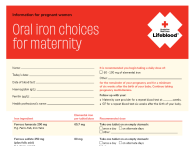Don’t have an account?
Select the donation type you’d like to make
Iron deficiency anaemia (IDA) is a common problem that often goes unrecognised.
IDA occurs at all stages of life and may be due to physiological, nutritional or social factors in at risk groups.
Iron deficiency is also often due to pathological processes and may be an indication of serious underlying conditions, such as malabsorptive disorders or gastrointestinal (GI) cancers.
Iron deficiency and IDA have a number of clinical consequences such as:
- anaemia
- decreased memory, impaired learning and concentration
- impaired immune function
- decreased aerobic sports performance
- decreased work productivity
- fatigue
- adverse pregnancy outcomes:
- increased risk of low birth weight
- increased risk of prematurity
- increased risk of maternal morbidity
- infant motor and mental function delay, and
- increased risk of transfusion and associated outcomes.
Improving the identification and management of IDA is important to ensure optimal health outcomes for patients and effective use of healthcare resources.



